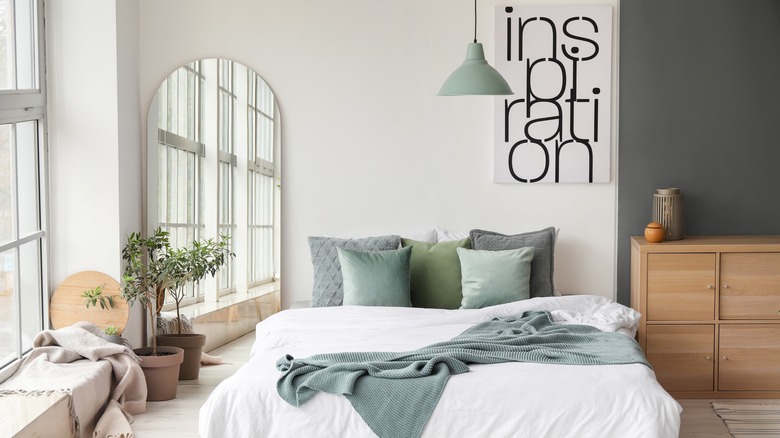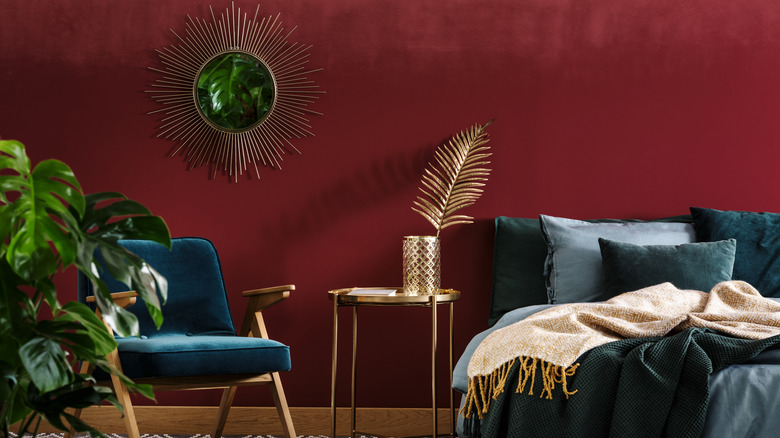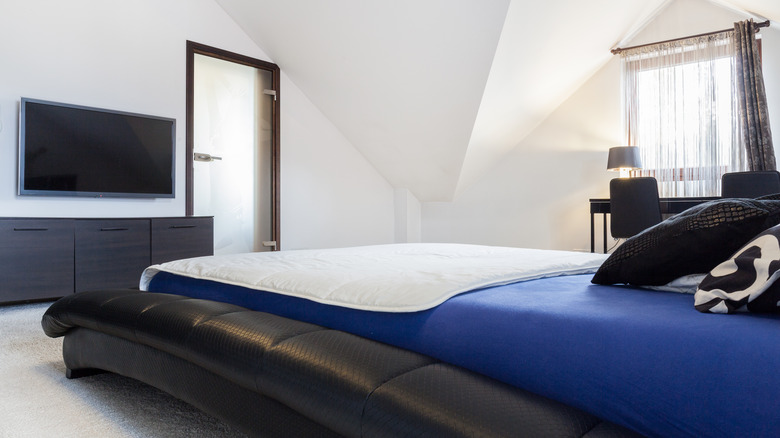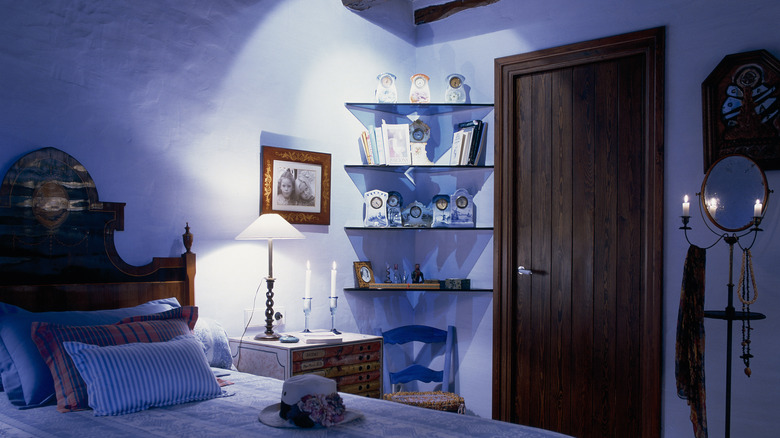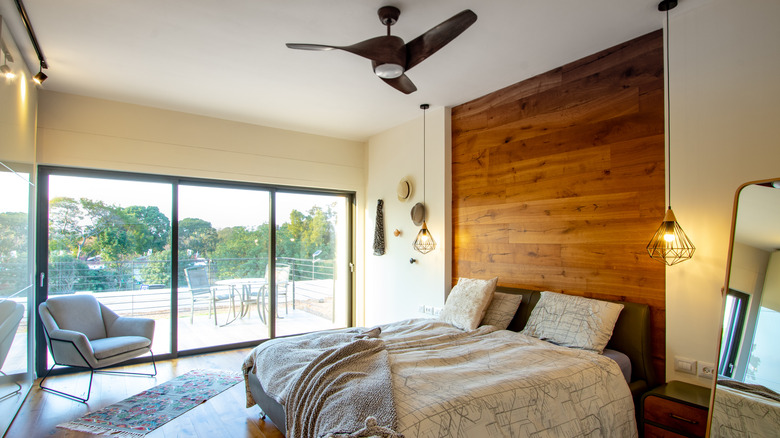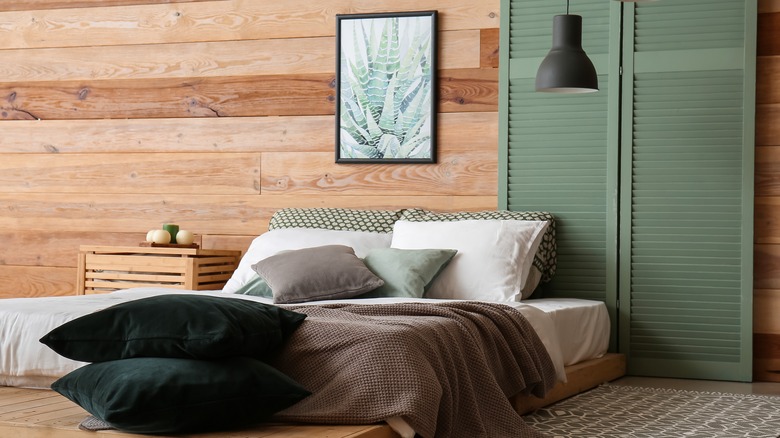5 Layout Mistakes You Are Making In Your Bedroom
You don't have to be a feng shui master to sense when an interior design concept isn't in alignment with the room it occupies. When you enter, something instantly feels out of proportion. The good news? That's often attributable to simple mistakes that can be easily corrected.
Your bedroom's layout is a prime component of your ability to rest, relax and recharge. Unfortunately, bedrooms also tend to be clutter magnets, so any pack rat tendencies we might have are frequently magnified a hundredfold. A large collection of shoes can become a minefield, or for those who love to read, a book collection can quickly swell to metropolitan library proportions. Like to watch TV in bed? Careful you don't turn your sleeping chamber into a sports arena.
Although there's no universal agreement on the topic, most designers can quickly identify what's wrong or at least point to their own personal pet peeves. Decorator Julie Khuu tells her YouTube fans that mistakes in the bedroom run the gamut, from choices about where to place furniture to sunlight keeping you awake, out-of-reach lamps, and bedding that ends up underfoot. When considering how to configure your bedroom, only you can decide what purposes it should serve. Some want a retreat, others want a romantic getaway, and still others want it to be a place where kids are welcome to come and romp at all hours of the day.
The view
You can often tell whether you're going to like a room from a quick glance inside. The configuration speaks volumes about the person who put it together or resides there, and you don't want a room frightening people away.
A common mistake is to push all your furniture — especially your bed — up against more than one wall. That's for prisons. Ideally, according to stylist Emily Henderson, it's better to have at least 36 inches of walking space around your bed. That provides enough room, she says, for most people to engage their equilibrium on the way to the bathroom or refrigerator in the wee hours.
In addition, try to avoid stuffing your bedroom with furniture. Likewise, accumulating large and bulky pieces that will make your room look too tiny for human habitation. Armoires are great if you have abundant space (or you're planning an occasional escape to Narnia), but they can quickly swallow a room because of their sheer size. A large piece can also give you a huge layout headache, because everything must fit around it. Heirloom pieces like armoires can often find other places to dwell.
Selecting the right color combinations is also integral to layout. Be careful in selecting dark colors to accompany your dark furnishings. You'll end up in room gloom with a space that could resemble a mortuary or a brothel. Conversely, says design expert Michelle Jett, you don't want walls so bright they keep you up at night.
Chunky style
Do you feel like Gulliver among the Lilliputians when you hit the sack? Your bed may be dominating the room. Ideally, all the furnishings in your bedroom will work harmoniously, even if they're mismatched. But if you find yourself turning sideways to get around your bed or having to move a nightstand or clothes rack just so you can make up your bed every morning, that's problematic. Some sleepers do love to luxuriate in the largest bed they can find; others swear that it's the only way they can sleep with a mate who tosses and turns the whole night through. But at what cost?
Sleeping is how human beings spend a third of their lives on the planet, notes Scientific American. And life, according to the professionals at Norhart, is too short to adopt a one-size-fits-all attitude here. Your bed — including not only its relative size, but its headboard and height off the floor — tells you a lot about who lives there and who's really in charge. A bed that's too big will look like an ocean liner in a bathtub. A great bed isn't cheap, either, so many homeowners will drag a frame they love from one bedroom to another, hoping they can make it work. But, ultimately, your eyes won't lie. Take a look around and notice whether your bed is appropriate to the size of the room. The telltale sign it's too big is whether it's dwarfing everything else in sight.
Lights out
Any bedroom layout should take proper lighting into account. How can you tell that a bedroom layout needs to have its lighting plot rethought? Nothing is in reach. Maybe you're one of those sleepers who likes a lamp far enough away to force you to leave your bed. That earns a pass. It's serving you.
But light, while an intangible, emanates from one of two places: the sun or your light fixtures. Once again, these should be in proportion to the rest of the room (you don't want a huge chandelier hanging inches from your face at night), and the standing lamps should be near enough to dressers and nooks so that you can find what you're looking for without having to turn on the overhead light and possibly disturb someone still asleep.
The designers at Maxine Brady explain how to arrange bedroom lighting well. Consider your bedroom activities: reading, watching TV, or applying and removing makeup. And, in the post-COVID era, people may increasingly find themselves working from their bed with a laptop.
Wall sconces, LED applications, floor and small adjustable table lamps address the problems nicely. Survey your surroundings and seek those places where lamps best serve you. Oftentimes corners are ideal, especially in smaller places like studio apartments and condos. If you're curious about what your options might be and how to best disperse light to create the ambience you want, we have a page dedicated to helping you decide.
Private eyes
One of the most regrettable layout mistakes in your bedroom is that you somehow have the feeling that you're never alone. Since one of a bedroom's primary functions is to provide you with a place where you can retreat from the world, what could be worse than putting yourself on display while you're in there?
This can happen in a couple of ways. Floor-to-ceiling sliding glass doors may seem très chic when you're home shopping, but as a practical matter, you're going to want some kind of window treatment, and pronto, say the professionals at My Move. Do you really want the public to have access to you while you change clothes, shower, or sleep without pajamas? Blinds, drapes, and curtains can solve a lot of these problems instantly. And that's not all. According to the Centers for Disease Control, you will sleep better in a darker room.
Now consider those intrusions from within. Some parents want kids to feel as though there's no barrier between them and anyone who's family, and so they keep kids' toys and family video games in the adults' bedroom. Life Hacker reports that might not be such a good idea. Love your kids, but use your bedroom door, and make sure it has a functional lock. If you must keep your door open, invest in a paneled screen so that you can hear your kids, but preserve your privacy, as well as your sanity.
Feng shui
Which leaves us to... everything else. Some designers love the idea of a bed that's low to the ground, as above. Others grouse that it telegraphs poverty, and that they're not as easy to climb out of as one at hip level. Some might look at the photo and compliment the shades of green against natural wood; others would wonder why the bed is backed up against the shutter screen behind.
So let's discuss bedroom feng shui, because it's actually simple, logical, and easy to implement. The designers at Roomlay insist you need the support and protection of a headboard (unlike the layout above). Likewise, beds should be placed as far from the entryway as possible and not in direct alignment with other doors leading into the room. They also recommend your flatscreen TV be hidden when not in use, and that if you have a desk, it shouldn't be next to where you're resting.
The Dreams site offers a feng shui diagram, advising that beds should be accessible from both sides, and you should avoid having mirrors facing the bed. If you don't have a carpet, are there rugs in place that you find appropriate to your needs and aesthetic? These questions may keep interior decorators up at night, but your main concern should be whether you've created a spot where you can let the world do its own thing for a bit while you do you.
